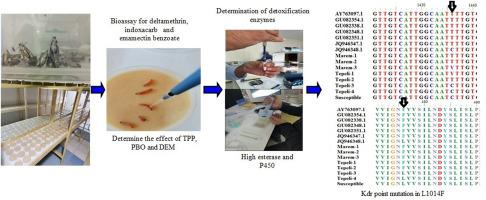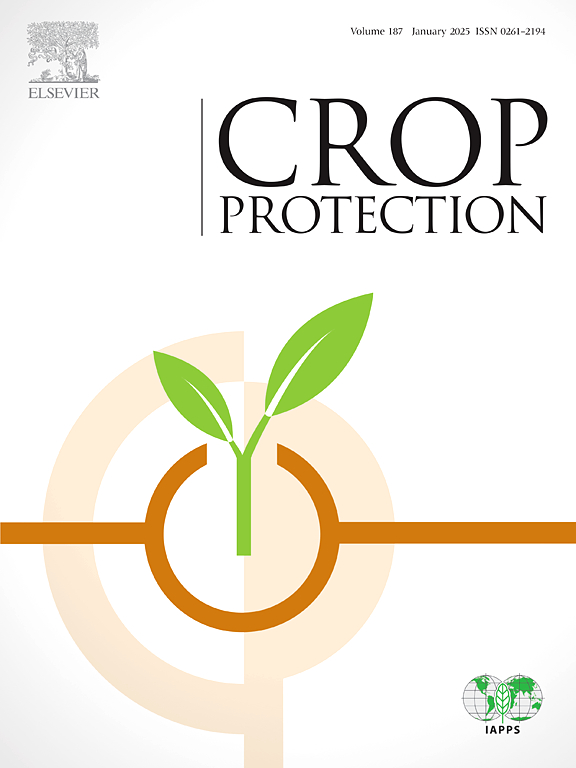Investigation of resistance ratios and resistance mechanisms of Cydia pomonella (L.) (lepidoptera: Tortricidae) populations collected from apple orchards in Isparta (Türkiye) against some insecticides
IF 2.5
2区 农林科学
Q1 AGRONOMY
引用次数: 0
Abstract
The codling moth, Cydia pomonella is an important pest that causes significant economic losses in apples and walnuts in the world. The aim of this study was to investigate, for the first time in Türkiye, the resistance status and resistance mechanisms of codling moth, Cydia pomonella against indoxacarb, deltamethrin and emamectin benzoate. All apple orchard populations developed resistance ratios ranging from 3.38 to 22.37-fold to deltamethrin, 5.67–29.87-fold to indoxacarb and 1.46–3.05-fold to emamectin benzoate. The interaction of some synergists triphenyl phosphate (TPP), piperonyl butoxide (PBO) and diethyl maleate (DEM) with indoxacarb and deltamethrin was analyzed in the susceptible, MAREM and Tepeli populations with moderate resistance to indoxacarb and deltamethrin. While indoxacarb + TPP showed a significant synergistic effect only in MAREM population, a significant synergistic effect was observed with indoxacarb + TPP and indoxacarb + PBO in Tepeli population. The activities of detoxifying enzymes [esterase, glutathion –S– transferase (GST) and cytochrome P450 monooxygenase (P450)] studied by biochemical methods showed some variation depending on the population. The results of biochemical analyses showed that esterase and GST enzyme activities of all populations was between 0.51 and 0.94, 0.77 and1.29 mOD min−1mg−1 proteins, respectively. The P450 enzyme activities ranged from 0.53 to 0.78, RFU min−1mg−1 proteins. In addition, the L1014F knockdown mutation (CTT to TTT) corresponding to leucine to phenylalanine amino acid substitution of the voltage-gated sodium channel in Cydia pomonella was determined in MAREM and Tepeli populations. It was determined that while MAREM and Tepeli populations developed moderate resistance, the other populations developed a low level resistance to deltamethrin and indoxacarb. On the other hand, all populations developed a low level resistance to emamectin benzoate. The P450 and esterase enzyme activities were significantly higher in MAREM and Tepeli populations which were resistant to deltamethrin and indoxacarb than the susceptible population. In addition, a Kdr point mutation L1014F was detected in the deltamethrin resistant MAREM and Tepeli populations.

调查从伊斯帕尔塔(土耳其)苹果园采集的蝶形花(鳞翅目:蛛形纲)种群对一些杀虫剂的抗性比率和抗性机制
苹果蠹蛾(Cydia pomonella)是一种重要害虫,给世界上的苹果和核桃造成了重大经济损失。本研究旨在首次在土耳其调查苹果蠹蛾对茚虫威、溴氰菊酯和苯甲酸乐果的抗性状况和抗性机制。所有苹果园种群对溴氰菊酯的抗性比率为 3.38 至 22.37 倍,对茚虫威的抗性比率为 5.67 至 29.87 倍,对苯甲酸乐果的抗性比率为 1.46 至 3.05 倍。在对茚虫威和溴氰菊酯具有中等抗性的易感群体、MAREM 和 Tepeli 群体中,分析了一些增效剂磷酸三苯酯(TPP)、胡椒基丁醚(PBO)和马来酸二乙酯(DEM)与茚虫威和溴氰菊酯的相互作用。茚虫威 + TPP 只在 MAREM 群体中显示出显著的增效作用,而在 Tepeli 群体中,茚虫威 + TPP 和茚虫威 + PBO 则显示出显著的增效作用。生化方法研究的解毒酶[酯酶、谷胱甘肽-S-转移酶(GST)和细胞色素 P450 单氧化酶(P450)]的活性因种群不同而存在一定差异。生化分析结果显示,所有种群的酯酶和 GST 酶活性分别为 0.51 至 0.94、0.77 至 1.29 mOD min-1mg-1 蛋白质。P450 酶活性介于 0.53 至 0.78 RFU min-1mg-1 蛋白质之间。此外,还在 MAREM 和 Tepeli 群体中测定了 L1014F 基因敲除突变(CTT 到 TTT),该突变对应于单胞菌电压门控钠通道的亮氨酸到苯丙氨酸的氨基酸替换。结果表明,MAREM 和 Tepeli 种群对溴氰菊酯和茚虫威具有中等抗性,而其他种群对溴氰菊酯和茚虫威具有低抗性。另一方面,所有种群都对苯甲酸阿维菌素产生了低水平的抗药性。对溴氰菊酯和茚虫威具有抗性的 MAREM 和 Tepeli 种群的 P450 酶和酯酶活性明显高于易感种群。此外,在对溴氰菊酯有抗性的 MAREM 和 Tepeli 群体中检测到了 Kdr 点突变 L1014F。
本文章由计算机程序翻译,如有差异,请以英文原文为准。
求助全文
约1分钟内获得全文
求助全文
来源期刊

Crop Protection
农林科学-农艺学
CiteScore
6.10
自引率
3.60%
发文量
200
审稿时长
29 days
期刊介绍:
The Editors of Crop Protection especially welcome papers describing an interdisciplinary approach showing how different control strategies can be integrated into practical pest management programs, covering high and low input agricultural systems worldwide. Crop Protection particularly emphasizes the practical aspects of control in the field and for protected crops, and includes work which may lead in the near future to more effective control. The journal does not duplicate the many existing excellent biological science journals, which deal mainly with the more fundamental aspects of plant pathology, applied zoology and weed science. Crop Protection covers all practical aspects of pest, disease and weed control, including the following topics:
-Abiotic damage-
Agronomic control methods-
Assessment of pest and disease damage-
Molecular methods for the detection and assessment of pests and diseases-
Biological control-
Biorational pesticides-
Control of animal pests of world crops-
Control of diseases of crop plants caused by microorganisms-
Control of weeds and integrated management-
Economic considerations-
Effects of plant growth regulators-
Environmental benefits of reduced pesticide use-
Environmental effects of pesticides-
Epidemiology of pests and diseases in relation to control-
GM Crops, and genetic engineering applications-
Importance and control of postharvest crop losses-
Integrated control-
Interrelationships and compatibility among different control strategies-
Invasive species as they relate to implications for crop protection-
Pesticide application methods-
Pest management-
Phytobiomes for pest and disease control-
Resistance management-
Sampling and monitoring schemes for diseases, nematodes, pests and weeds.
 求助内容:
求助内容: 应助结果提醒方式:
应助结果提醒方式:


